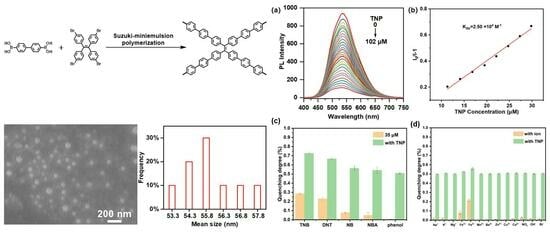Tetraphenylethene-Based Cross-Linked Conjugated Polymer Nanoparticles for Efficient Detection of 2,4,6-Trinitrophenol in Aqueous Phase
Abstract
:1. Introduction
2. Experiment
2.1. Reagents and Measurements
2.2. Synthesis
3. Results and Discussion
3.1. Synthesis and Characterization
3.2. Morphology and Porosity
3.3. Photophysical Property
3.4. Detection of Nitroaromatic Explosives in the Aqueous Phase
3.5. Selectivity of TNP Detection
3.6. Application
3.7. Fluorescence Sensing Mechanism
4. Conclusions
Supplementary Materials
Author Contributions
Funding
Data Availability Statement
Acknowledgments
Conflicts of Interest
References
- Kumar, S.; Venkatramaiah, N.; Patil, S. Fluoranthene Based Derivatives for Detection of Trace Explosive Nitroaromatics. J. Phys. Chem. C 2013, 117, 7236–7245. [Google Scholar] [CrossRef]
- Yang, J.-S.; Swager, T.M. Fluorescent Porous Polymer Films as TNT Chemosensors: Electronic and Structural Effects. J. Am. Chem. Soc. 1998, 120, 11864–11873. [Google Scholar] [CrossRef]
- Sohn, H.; Calhoun, R.M.; Sailor, M.J.; Trogler, W.C. Detection of TNT and Picric Acid on Surfaces and in Seawater by Using Photoluminescent Polysiloles. Angew. Chem. Int. Ed. 2001, 113, 2162–2163. [Google Scholar] [CrossRef]
- Kasthuri, S.; Shiv, K.; Raviteja, S.; Buthanapalli, R.; Samarendra, M.; Veeraiah, N.; Venkatramaiah, N. Influence of Alkyl Chains on Fluoranthene Ensembles towards Fluorescence-Based Detection of 2,4,6-Trinitrophenol. Appl. Surf. Sci. 2019, 481, 1018–1027. [Google Scholar] [CrossRef]
- Vij, V.; Bhalla, V.; Kumar, M. Attogram Detection of Picric Acid by Hexa-Peri-Hexabenzocoronene-Based Chemosensors by Controlled Aggregation-Induced Emission Enhancement. ACS Appl. Mater. Interfaces 2013, 5, 5373–5380. [Google Scholar] [CrossRef] [PubMed]
- Xiang, K.; Li, Y.; Xu, C.; Li, S. POSS-Based Organic–Inorganic Hybrid Nanomaterials: Aggregation-Enhanced Emission, and Highly Sensitive and Selective Detection of Nitroaromatic Explosives in Aqueous Media. J. Mater. Chem. C 2016, 4, 5578–5583. [Google Scholar] [CrossRef]
- Peng, Y.; Zhang, A.-J.; Dong, M.; Wang, Y.-W. A Colorimetric and Fluorescent Chemosensor for the Detection of an Explosive—2,4,6-Trinitrophenol (TNP). Chem. Commun. 2011, 47, 4505. [Google Scholar] [CrossRef]
- Guo, X.; Gao, B.; Cui, X.; Wang, J.; Dong, W.; Duan, Q.; Fei, T.; Su, Z. PL Sensor for Sensitive and Selective Detection of 2,4,6-Trinitrophenol Based on Carbazole and Tetraphenylsilane Polymer. Dye. Pigment. 2021, 191, 109379. [Google Scholar] [CrossRef]
- Witanowski, M.; Urbanski, T.; Stefaniak, L. Nitrogen-14 Nuclear Magnetic Resonance in Nitro Compounds. J. Am. Chem. Soc. 1964, 86, 2569–2570. [Google Scholar] [CrossRef]
- Gungor, S.A.; Sahin, I.; Gungor, O.; Kariper, S.E.; Tumer, F.; Kose, M. Pamoic Acid Esters and Their Xanthene Derivatives: Flourimetric Detection of Nitroaromatic Compounds and Non-Linear Optical Properties. Sens. Actuators B Chem. 2018, 255, 3344–3354. [Google Scholar] [CrossRef]
- Zhang, Y.; Ma, X.; Zhang, S.; Yang, C.; Ouyang, Z.; Zhang, X. Direct Detection of Explosives on Solid Surfaces by Low Temperature Plasma Desorption Mass Spectrometry. Anal. 2009, 134, 176–181. [Google Scholar] [CrossRef] [PubMed]
- Gu, C.; Huang, N.; Wu, Y.; Xu, H.; Jiang, D. Design of Highly Photofunctional Porous Polymer Films with Controlled Thickness and Prominent Microporosity. Angew. Chem. Int. Ed. 2015, 54, 11540–11544. [Google Scholar] [CrossRef] [PubMed]
- Dong, W.; Ma, Q.; Ma, Z.; Duan, Q.; Lü, X.; Qiu, N.; Fei, T.; Su, Z. Phosphorescent Iridium(III) Complex Based Photoluminescence Sensor for Sensitive and Selective Detection of Picric Acid. Dye. Pigment. 2020, 172, 107799. [Google Scholar] [CrossRef]
- Fei, T.; Jiang, K.; Zhang, T. Highly Sensitive TNT Photoluminescent Sensing by a Phosphorescent Complex. Sens. Actuators B Chem. 2014, 199, 148–153. [Google Scholar] [CrossRef]
- Dong, W.; Fei, T.; Palma-Cando, A.; Scherf, U. Aggregation Induced Emission and Amplified Explosive Detection of Tetraphenylethylene-Substituted Polycarbazoles. Polym. Chem. 2014, 5, 4048. [Google Scholar] [CrossRef]
- Sun, X.; Wang, Y.; Lei, Y. Fluorescence Based Explosive Detection: From Mechanisms to Sensory Materials. Chem. Soc. Rev. 2015, 44, 8019–8061. [Google Scholar] [CrossRef] [PubMed]
- Varnaseri, N.; Ramazani, A.; Morsali, A.; Rouhani, F. Pore Wall Functionalized Ultrasonically Synthesized Cooperative MOF for Luminescence Sensing of 2,4,6-Trinitrophenol. J. Solid State Chem. 2020, 291, 121622. [Google Scholar] [CrossRef]
- Roberts, J.M.; Fini, B.M.; Sarjeant, A.A.; Farha, O.K.; Hupp, J.T.; Scheidt, K.A. Urea Metal–Organic Frameworks as Effective and Size-Selective Hydrogen-Bond Catalysts. J. Am. Chem. Soc. 2012, 134, 3334–3337. [Google Scholar] [CrossRef]
- Xiang, Z.; Fang, C.; Leng, S.; Cao, D. An Amino Group Functionalized Metal–Organic Framework as a Luminescent Probe for Highly Selective Sensing of Fe3+ Ions. J. Mater. Chem. A 2014, 2, 7662. [Google Scholar] [CrossRef]
- Arslan, M.; Yilmaz Sengel, T.; Guler, E.; Gumus, Z.P.; Aldemir, E.; Akbulut, H.; Coskunol, H.; Timur, S.; Yagci, Y. Double Fluorescence Assay via a β-Cyclodextrin Containing Conjugated Polymer as a Biomimetic Material for Cocaine Sensing. Polym. Chem. 2017, 8, 3333–3340. [Google Scholar] [CrossRef]
- Chen, L.; McBranch, D.; Wang, R.; Whitten, D. Surfactant-Induced Modification of Quenching of Conjugated Polymer Fluorescence by Electron Acceptors: Applications for Chemical Sensing. Chem. Phys. Lett. 2000, 330, 27–33. [Google Scholar] [CrossRef]
- Li, N.; Liu, S.G.; Fan, Y.Z.; Ju, Y.J.; Xiao, N.; Luo, H.Q.; Li, N.B. Adenosine-Derived Doped Carbon Dots: From an Insight into Effect of N/P Co-Doping on Emission to Highly Sensitive Picric Acid Sensing. Anal. Chim. Acta 2018, 1013, 63–70. [Google Scholar] [CrossRef]
- Yang, K.; Jia, P.; Hou, J.; Bu, T.; Sun, X.; Liu, Y.; Wang, L. Innovative Dual-Emitting Ratiometric Fluorescence Sensor for Tetracyclines Detection Based on Boron Nitride Quantum Dots and Europium Ions. ACS Sustain. Chem. Eng. 2020, 8, 17185–17193. [Google Scholar] [CrossRef]
- Huang, S.; Li, W.; Zhou, X.; Xie, M.; Luo, Q.; Wen, H.; Luo, Y.; Xue, W. One-Step Synthesis of Levodopa Functionalized Carbon Quantum Dots for Selective Detection of Tyrosinase and Inhibitor Screening. Microchem. J. 2020, 159, 105456. [Google Scholar] [CrossRef]
- Ma, Y.; Xu, S.; Wang, S.; Wang, L. Luminescent Molecularly-Imprinted Polymer Nanocomposites for Sensitive Detection. TrAC Trends Anal. Chem. 2015, 67, 209–216. [Google Scholar] [CrossRef]
- Xiang, Z.; Xue, Y.; Cao, D.; Huang, L.; Chen, J.-F.; Dai, L. Highly Efficient Electrocatalysts for Oxygen Reduction Based on 2D Covalent Organic Polymers Complexed with Non-Precious Metals. Angew. Chem. Int. Ed. 2014, 53, 2433–2437. [Google Scholar] [CrossRef]
- Tripathi, N.; Sandhu, S.; Singh, P.; Mahajan, A.; Kaur, M.; Kumar, S. Dansyl Conjugated Tripodal AIEEgen for Highly Selective Detection of 2,4,6-Trinitrophenol in Water and Solid State. Sens. Actuators B Chem. 2016, 231, 79–87. [Google Scholar] [CrossRef]
- Su, C.; Tandiana, R.; Tian, B.; Sengupta, A.; Tang, W.; Su, J.; Loh, K.P. Visible-Light Photocatalysis of Aerobic Oxidation Reactions Using Carbazolic Conjugated Microporous Polymers. ACS Catal. 2016, 6, 3594–3599. [Google Scholar] [CrossRef]
- Yu, J.W.; Jung, J.; Choi, Y.-M.; Choi, J.H.; Yu, J.; Lee, J.K.; You, N.-H.; Goh, M. Enhancement of the Crosslink Density, Glass Transition Temperature, and Strength of Epoxy Resin by Using Functionalized Graphene Oxide Co-Curing Agents. Polym. Chem. 2016, 7, 36–43. [Google Scholar] [CrossRef]
- Hu, R.; Leung, N.L.C.; Tang, B.Z. AIE Macromolecules: Syntheses, Structures and Functionalities. Chem Soc. Rev. 2014, 43, 4494–4562. [Google Scholar] [CrossRef]
- Aguila, B.; Sun, Q.; Perman, J.A.; Earl, L.D.; Abney, C.W.; Elzein, R.; Schlaf, R.; Ma, S. Efficient Mercury Capture Using Functionalized Porous Organic Polymer. Adv. Mater. 2017, 29, 1700665. [Google Scholar] [CrossRef] [PubMed]
- Kandambeth, S.; Shinde, D.B.; Panda, M.K.; Lukose, B.; Heine, T.; Banerjee, R. Enhancement of Chemical Stability and Crystallinity in Porphyrin-Containing Covalent Organic Frameworks by Intramolecular Hydrogen Bonds. Angew. Chem. Int. Ed. 2013, 52, 13052–13056. [Google Scholar] [CrossRef] [PubMed]
- Wu, J.; Xu, F.; Li, S.; Ma, P.; Zhang, X.; Liu, Q.; Fu, R.; Wu, D. Porous Polymers as Multifunctional Material Platforms toward Task-Specific Applications. Adv. Mater. 2019, 31, 1802922. [Google Scholar] [CrossRef] [PubMed]
- He, M.; Ou, X.; Wang, Y.; Chen, Z.; Li, D.; Chen, B.; Hu, B. Porous Organic Frameworks-Based (Micro)Extraction. J. Chromatogr. A 2020, 1609, 460477. [Google Scholar] [CrossRef]
- Dong, Y.; Lam, J.W.Y.; Qin, A.; Liu, J.; Li, Z.; Tang, B.Z.; Sun, J.; Kwok, H.S. Aggregation-Induced Emissions of Tetraphenylethene Derivatives and Their Utilities as Chemical Vapor Sensors and in Organic Light-Emitting Diodes. Appl. Phys. Lett. 2007, 91, 011111. [Google Scholar] [CrossRef]
- Cui, Q.; Guo, X.; Zhang, W.; Dong, W.; Duan, Q. Preparation of Porous Organic Polymer Nanoparticles in Miniemulsion for 2,4,6-Trinitrophenol Sensing. Dye. Pigment. 2023, 208, 110843. [Google Scholar] [CrossRef]
- Eddin, M.Z.; Zhilina, E.F.; Chuvashov, R.D.; Dubovik, A.I.; Mekhaev, A.V.; Chistyakov, K.A.; Baranova, A.A.; Khokhlov, K.O.; Rusinov, G.L.; Verbitskiy, E.V.; et al. Random Copolymers of Styrene with Pendant Fluorophore Moieties: Synthesis and Applications as Fluorescence Sensors for Nitroaromatics. Molecules 2022, 27, 6957. [Google Scholar] [CrossRef]
- Zhang, W.; Cui, Q.; Guo, X.; Ouyang, T.; Dong, W.; Duan, Q. Highly Sensitive, Selective and Reliable Detection of Picric Acid in Aqueous Media Based on Conjugated Porous Polymer Nanoparticles. Microchem. J. 2022, 183, 108022. [Google Scholar] [CrossRef]
- Akkoc, E.; Karagoz, B. One Step Synthesis of Crosslinked Fluorescent Microspheres for the Effective and Selective Sensing of Explosives in Aqueous Media. Eur. Polym. J. 2022, 172, 111238. [Google Scholar] [CrossRef]
- Dineshkumar, S.; Laskar, I.R. Study of the Mechanoluminescence and ‘Aggregation-Induced Emission Enhancement’ Properties of a New Conjugated Oligomer Containing Tetraphenylethylene in the Backbone: Application in the Selective and Sensitive Detection of Explosive. Polym. Chem. 2018, 9, 5123–5132. [Google Scholar] [CrossRef]
- Li, B.; Hu, R.; Qin, A.; Tang, B.Z. Copper-Based Ionic Liquid-Catalyzed Click Polymerization of Diazides and Diynes toward Functional Polytriazoles for Sensing Applications. Polym. Chem. 2020, 11, 2006–2014. [Google Scholar] [CrossRef]
- Turhan, H.; Tukenmez, E.; Karagoz, B.; Bicak, N. Highly Fluorescent Sensing of Nitroaromatic Explosives in Aqueous Media Using Pyrene-Linked PBEMA Microspheres. Talanta 2018, 179, 107–114. [Google Scholar] [CrossRef] [PubMed]
- Wu, H.; Tao, F.; Cui, Y.; Guo, L. Two Triphenylamine-Based AIE Materials for the Detection of PA in Aqueous Medium. Mater. Chem. Phys. 2020, 240, 122141. [Google Scholar] [CrossRef]
- Luo, Z.; Liu, B.; Si, S.; Lin, Y.; Luo, C.S.; Pan, C.; Zhao, C.; Wang, L. A Fluorescent Chemosensor Based on Nonplanar Donor-Acceptor Structure for Highly Sensitive and Selective Detection of Picric Acid in Water. Dye. Pigment. 2017, 143, 463–469. [Google Scholar] [CrossRef]
- Ma, Y.; Zhang, Y.; Liu, X.; Zhang, Q.; Kong, L.; Tian, Y.; Li, G.; Zhang, X.; Yang, J. AIE-Active Luminogen for Highly Sensitive and Selective Detection of Picric Acid in Water Samples: Pyridyl as an Effective Recognition Group. Dye. Pigment. 2019, 163, 1–8. [Google Scholar] [CrossRef]
- Parmar, B.; Rachuri, Y.; Bisht, K.K.; Laiya, R.; Suresh, E. Mechanochemical and Conventional Synthesis of Zn(II)/Cd(II) Luminescent Coordination Polymers: Dual Sensing Probe for Selective Detection of Chromate Anions and TNP in Aqueous Phase. Inorg. Chem. 2017, 56, 2627–2638. [Google Scholar] [CrossRef]
- Zhang, L.; Sun, Y.; Jiang, Y.; Li, Y.; Song, G.; Huang, K.; Yao, Z. Visual Sensing of Picric Acid in 100% Aqueous Media Based on Supramolecular Polythiophene Assemblies with Colorimetric and Fluorescent Dual Response. Chin. Chem. Lett. 2020, 31, 2428–2432. [Google Scholar] [CrossRef]
- Hou, C.Y.; Wang, C.; Xing, Y.H.; Bai, F.Y. Fluorescence Detection of Metals and Nitro Aromatic Compounds Based on Tetrastyrene Derivatives. J. Inorg. Organomet. Polym. Mater. 2020, 30, 1162–1171. [Google Scholar] [CrossRef]
- Ye, D.-Y.; Dong, Z.-Y.; Pu, Y.-Q.; Huang, G.-W.; An, Y.; Lü, C.-W. Design Two Large Conjugate Triazolopyrimidine Analogs and Apply Them to Detect 2,4,6-Trinitrophenol. Dye. Pigment. 2020, 174, 108016. [Google Scholar] [CrossRef]
- Liu, G.; Abdurahman, A.; Zhang, Z.; Feng, Y.; Li, F.; Zhang, M. New Three-Component Conjugated Polymers and Their Application as Super Rapid-Response Fluorescent Probe to DNT Vapor. Sens. Actuators B Chem. 2019, 296, 126592. [Google Scholar] [CrossRef]
- Duraimurugan, K.; Balasaravanan, R.; Siva, A. Electron Rich Triphenylamine Derivatives (D-π-D) for Selective Sensing of Picric Acid in Aqueous Media. Sens. Actuators B Chem. 2016, 231, 302–312. [Google Scholar] [CrossRef]
- Song, Y.; Lü, J.; Liu, B.; Lü, C. Temperature Responsive Polymer Brushes Grafted from Graphene Oxide: An Efficient Fluorescent Sensing Platform for 2,4,6-Trinitrophenol. J. Mater. Chem. C 2016, 4, 7083–7092. [Google Scholar] [CrossRef]

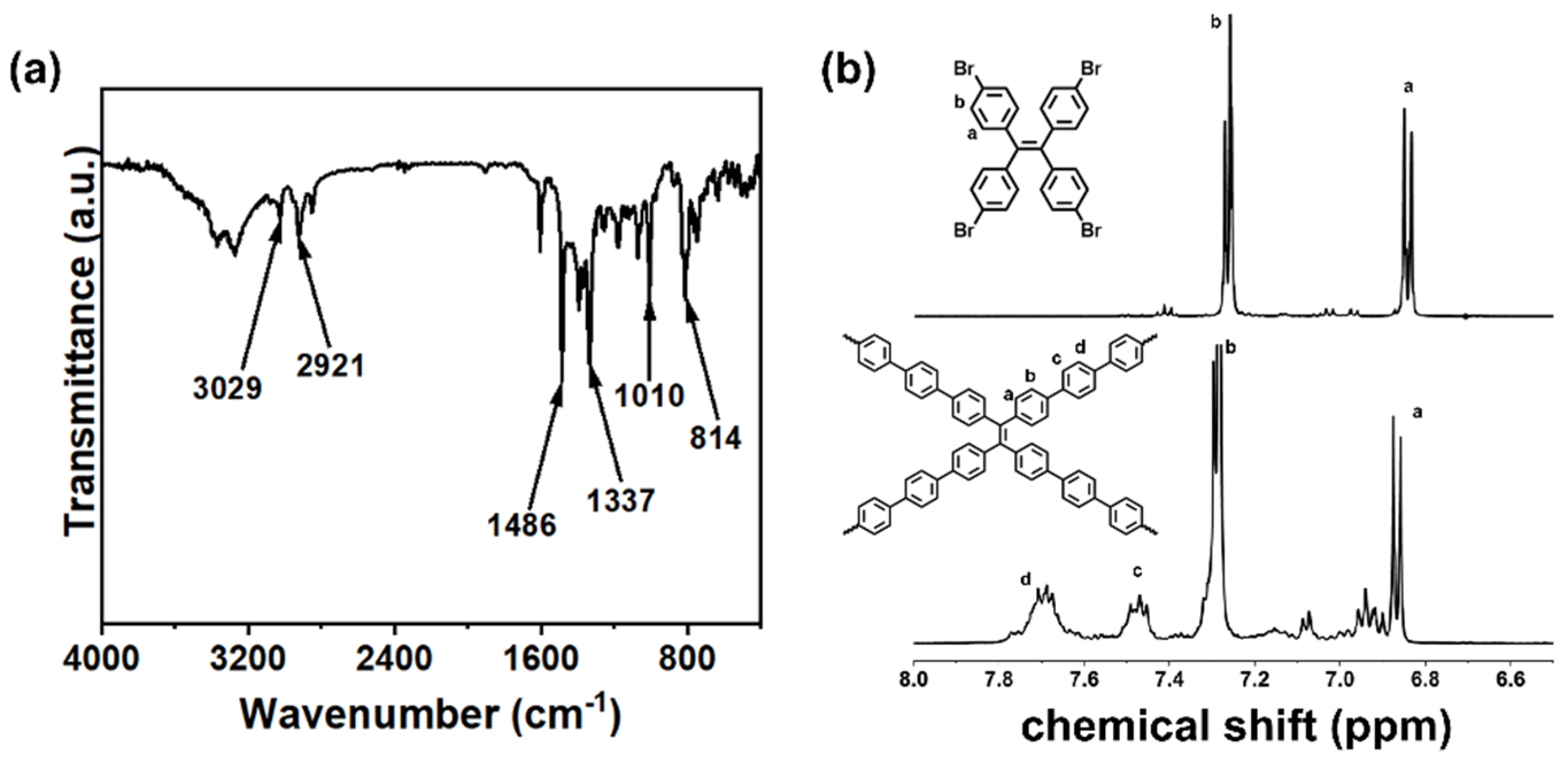
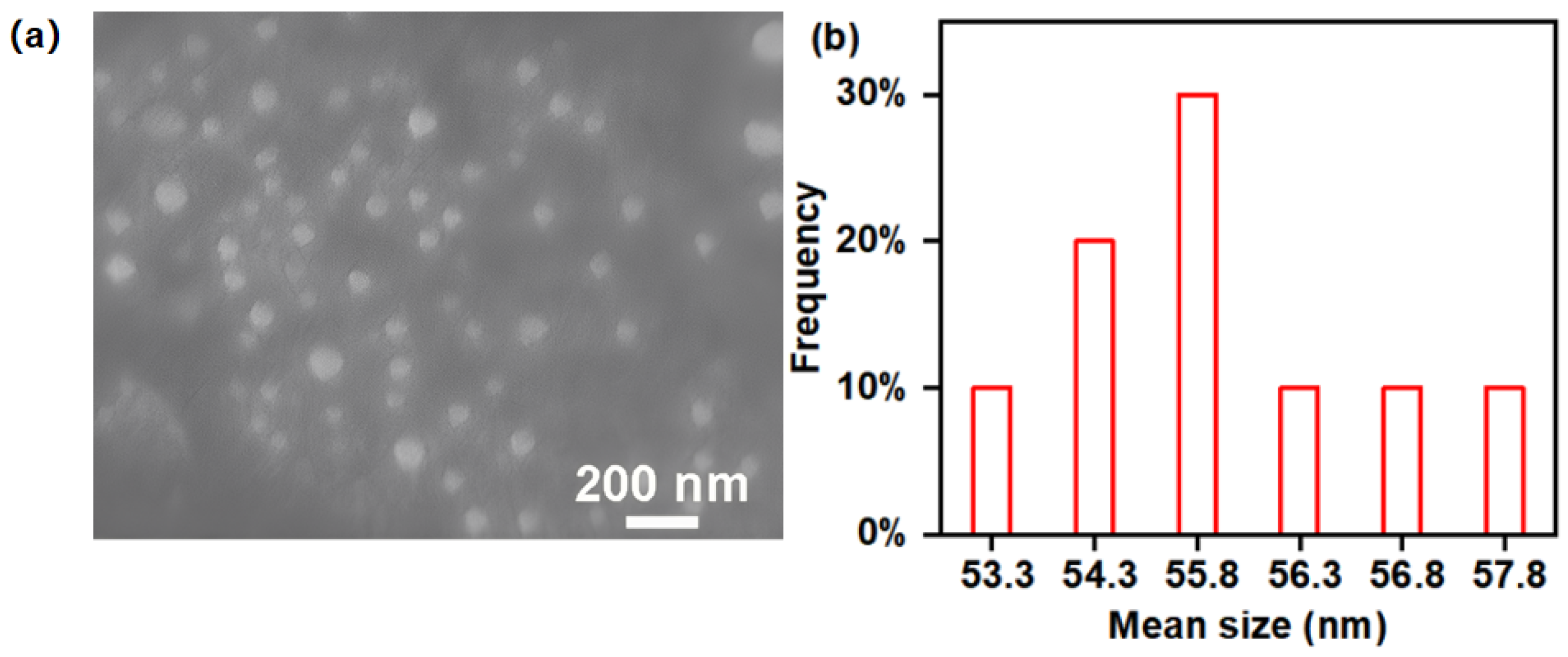
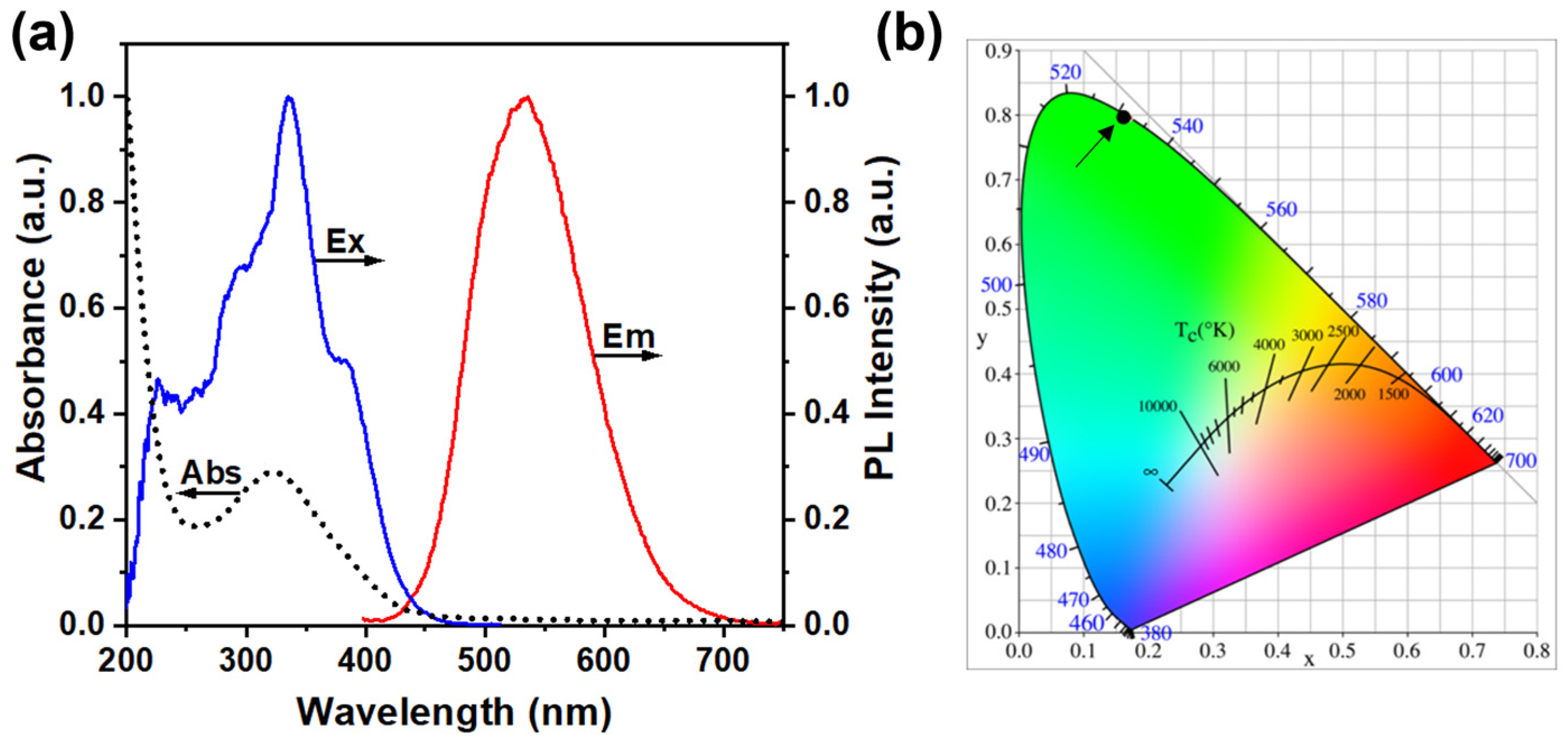


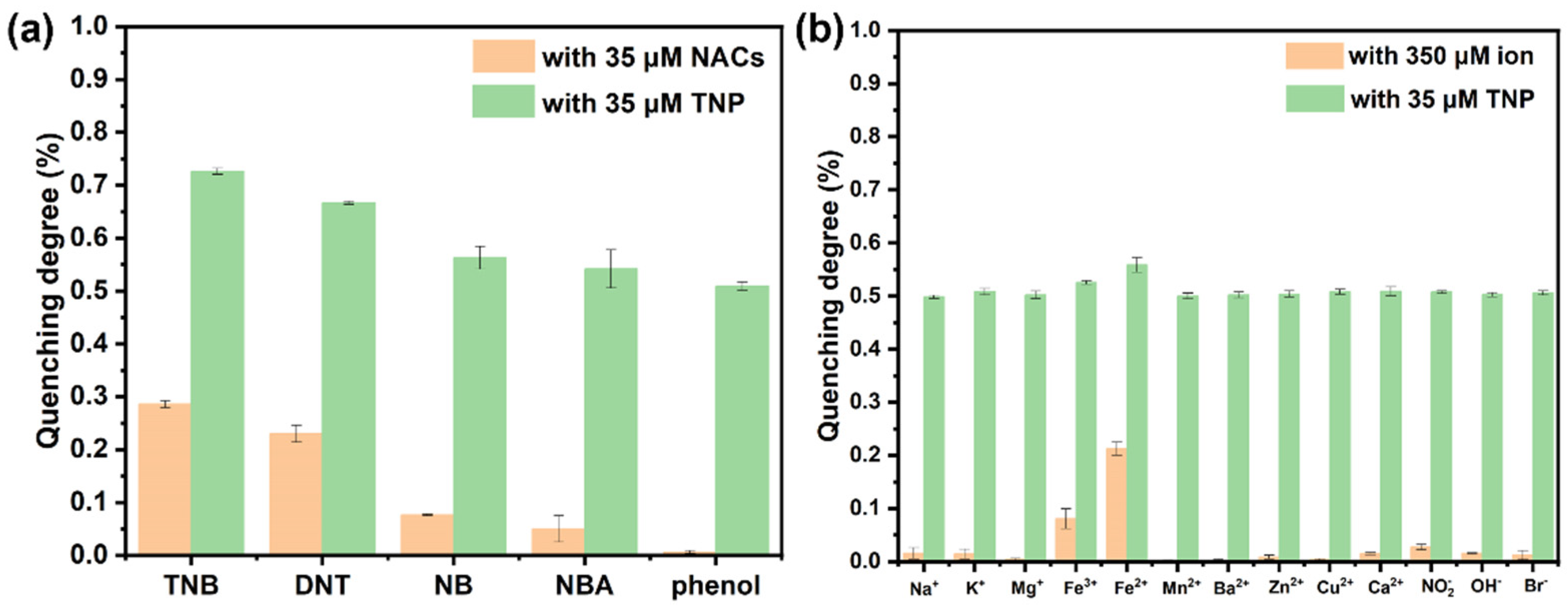



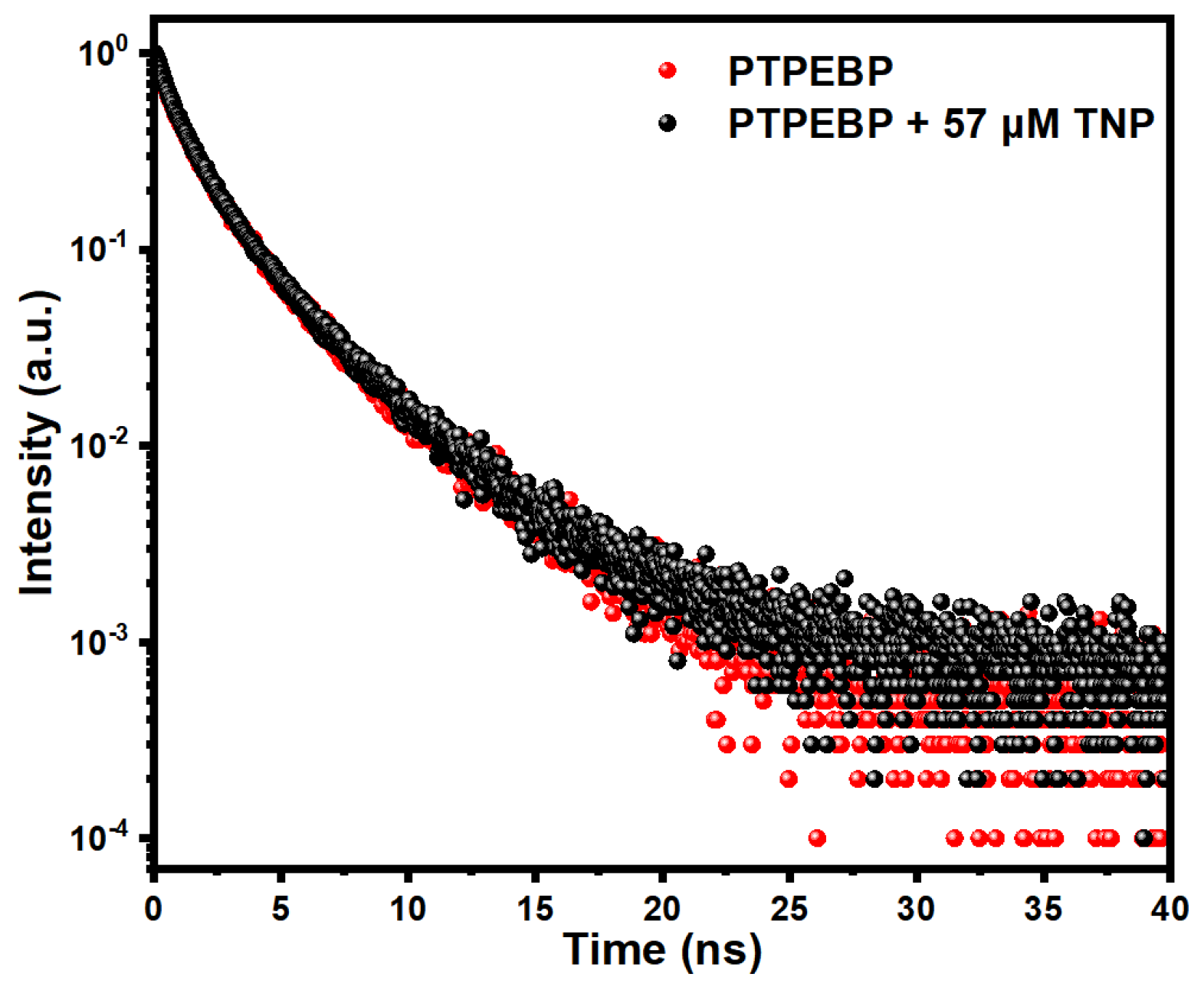
| Polymeric Material | Ksv (M−1) | LOD | Ref. |
|---|---|---|---|
| PTPEBP | 2.50 × 104 | 1.07 μM | This Work |
| PTATE2 | 1.8 × 104 | 722 nM | [36] |
| PTATE4 | 2.4 × 104 | 564 nM | [36] |
| P1 | 405.79 × 104 | 0.174 μM | [37] |
| P2 | 89.16 × 104 | 0.511 μM | [37] |
| P3 | 40.25 × 104 | 0.355 μM | [37] |
| P3* | 42.36 × 104 | 1.18 μM | [37] |
| P4 | 54.21 × 104 | 0.478 μM | [37] |
| P5 | 76.24 × 104 | 0.174 μM | [37] |
| PTPA-TPE | 3.2 × 104 | 316 nM | [38] |
| PTPA-TPE2 | 2.8 × 104 | 485 nM | [38] |
| P(PySt-EGDMA) | 2.4 × 104 | 0.329 μM | [39] |
| oTPETP | 1.64 × 102 | 0.053 mM | [40] |
| P1e2c | 1.72 × 104 | 510 nM | [41] |
| PBEMA | 2.45 × 105 | 0.11 μM | [42] |
| SM-1 | 1.1 × 105 | 1.9 μM | [43] |
| SM-2 | 5.3 × 104 | 93 ppb | [43] |
| BTPC | 1.93 × 104 | 370 nM | [44] |
| APPTPEP | 2.30 × 106 | 31.5 nM | [45] |
| CP1 | 2.16 × 104 | 28 ppb | [46] |
| CP2 | 1.52 × 104 | 14 ppb | [46] |
| PMTPBA | 7.15 × 105 | 5.0 × 10−8 M | [47] |
| λAbs (nm) | λEx (nm) | λEm (nm) | FWHM (nm) | PLQY (%) | CIE (x, y) | |
|---|---|---|---|---|---|---|
| PTPEBP | 320 | 336 | 532 | 110 | 8.14 | (0.17, 0.80) |
| Water Sample | Spike (mg/L) | Found (mg/L) | RSD (%) | Recovery (%) | |
|---|---|---|---|---|---|
| PTPEBP | Deionized Water | 5.00 | 4.90 ± 0.10 | 2.04 | 98.00 |
| Mineral Water | 5.00 | 4.97 ± 0.08 | 1.61 | 99.37 | |
| Tap Water | 5.00 | 5.07 ± 0.11 | 2.18 | 101.32 |
| S | tref. | Result | ||||
|---|---|---|---|---|---|---|
| Deionized Water | 0.10 | 5.00 | 4.90 | 1.73 | 4.30 | 1.73 < tref. (acceptable) |
| Mineral Water | 0.08 | 5.00 | 4.97 | 0.65 | 4.30 | 0.65 < tref. (acceptable) |
| Tap Water | 0.11 | 5.00 | 5.07 | 1.10 | 4.30 | 1.10 < tref. (acceptable) |
Disclaimer/Publisher’s Note: The statements, opinions and data contained in all publications are solely those of the individual author(s) and contributor(s) and not of MDPI and/or the editor(s). MDPI and/or the editor(s) disclaim responsibility for any injury to people or property resulting from any ideas, methods, instructions or products referred to in the content. |
© 2023 by the authors. Licensee MDPI, Basel, Switzerland. This article is an open access article distributed under the terms and conditions of the Creative Commons Attribution (CC BY) license (https://creativecommons.org/licenses/by/4.0/).
Share and Cite
Li, S.; Ouyang, T.; Guo, X.; Dong, W.; Ma, Z.; Fei, T. Tetraphenylethene-Based Cross-Linked Conjugated Polymer Nanoparticles for Efficient Detection of 2,4,6-Trinitrophenol in Aqueous Phase. Materials 2023, 16, 6458. https://doi.org/10.3390/ma16196458
Li S, Ouyang T, Guo X, Dong W, Ma Z, Fei T. Tetraphenylethene-Based Cross-Linked Conjugated Polymer Nanoparticles for Efficient Detection of 2,4,6-Trinitrophenol in Aqueous Phase. Materials. 2023; 16(19):6458. https://doi.org/10.3390/ma16196458
Chicago/Turabian StyleLi, Shengjie, Tianwen Ouyang, Xue Guo, Wenyue Dong, Zhihua Ma, and Teng Fei. 2023. "Tetraphenylethene-Based Cross-Linked Conjugated Polymer Nanoparticles for Efficient Detection of 2,4,6-Trinitrophenol in Aqueous Phase" Materials 16, no. 19: 6458. https://doi.org/10.3390/ma16196458
APA StyleLi, S., Ouyang, T., Guo, X., Dong, W., Ma, Z., & Fei, T. (2023). Tetraphenylethene-Based Cross-Linked Conjugated Polymer Nanoparticles for Efficient Detection of 2,4,6-Trinitrophenol in Aqueous Phase. Materials, 16(19), 6458. https://doi.org/10.3390/ma16196458




